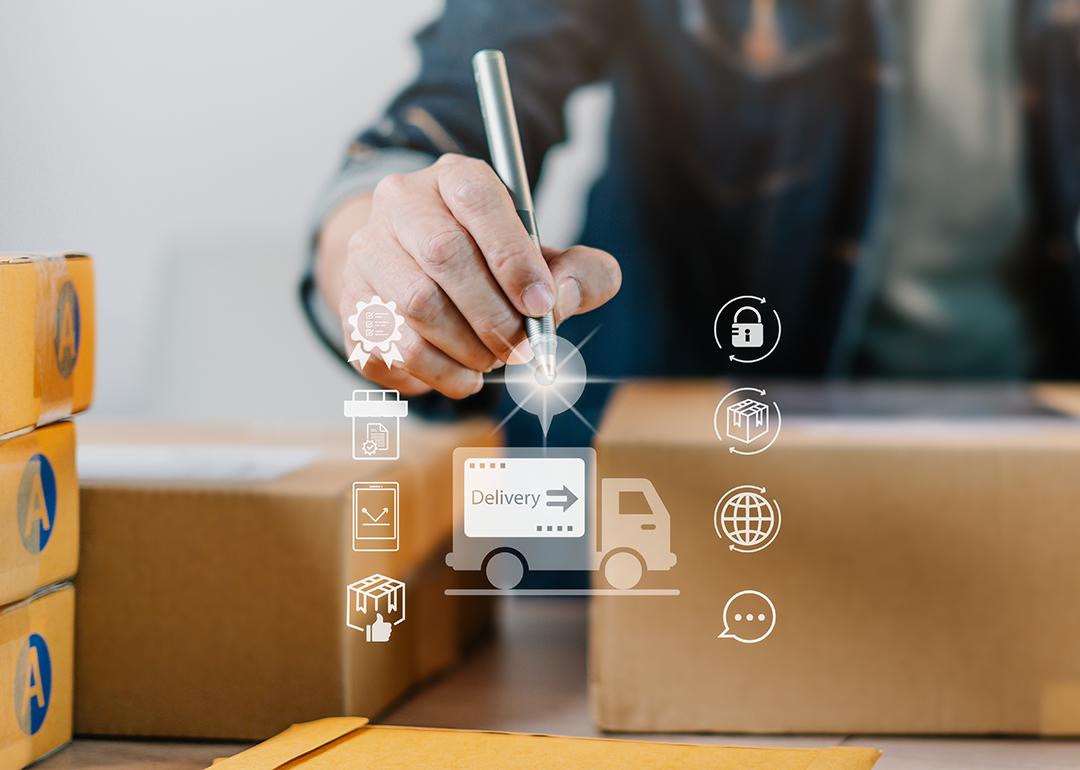
When is ecommerce fulfillment outsourcing the best option?
When is ecommerce fulfillment outsourcing the best option?
No two ecommerce brands are exactly alike. Businesses selling similar products can have very different fulfillment needs based on their location, growth trajectory, and customer expectations. In short, there’s no one-size-fits-all approach to fulfillment.
But the decision matters. Your choice to outsource or not will impact margins, customer experience, and other areas of your ecommerce business. It often comes down to cost savings, control, and business model advantages.
Here are factors ShipStation suggests businesses take into account before deciding to outsource fulfillment or manage it in-house.
Keep reading to learn:
- When self-fulfillment makes sense
- The clear signals it’s time to outsource
- How fulfillment needs evolve over time
- A practical framework for deciding on in-house fulfillment vs. a third-party logistics provider (3PL)
This article shares insights from ShipStation’s Innovation Delivered summit, where ecommerce experts shared tips for building strong businesses that focus on customers.
Why order volume alone doesn’t tell the story
Some ecommerce leaders only consider order volume when choosing their fulfillment approach. But order volume is only part of the equation.
As 3PL partners continue to improve, the barrier to entry for outsourcing gets lower and lower. It’s no longer just for Fortune 1000 companies. It’s now a viable strategy for companies of all sizes—even micro-merchants—which is why order volume alone shouldn’t drive your decision.
When direct fulfillment still makes sense
For many ecommerce brands, self-fulfillment is a deliberate choice that reflects their preferences for control, agility, and improved margins. Brands opt for self-fulfillment in the long term for multiple reasons, but here are some of the most common.
Product category matters
Some products are better for self-fulfillment than others. Lightweight, low-complexity items like makeup brushes, socks, and accessories are relatively easy to store and ship. That makes them a natural fit for self-fulfillment, as there are fewer steps and obstacles throughout the ordering and shipping process.
Outsourcing is typically the better option for heavy, oversized products. They require special storage, packaging, and shipping solutions that smaller brands may struggle to deliver directly to consumers.
Cost considerations
Finally, you might also choose self-fulfillment to optimize costs. For example, if margins are thin and order volume is manageable, in-house fulfillment may be cheaper than outsourcing. Keep in mind that outsourcing too early creates new overhead without necessarily improving the customer experience.
The business model advantage
Keeping fulfillment internal offers some other benefits, such as:
- Direct control over your packaging
- The ability to pivot promotions or bundles instantly
- Real-time inventory adjustments, so you can share more up-to-date information with consumers and partners
These advantages may or may not be important to your brand, but are worth taking into account during your decision-making process.
4 clear signals it’s time to outsource ecommerce fulfillment
As order volume grows and complexity increases, fulfillment tasks can pull leaders away from more strategic work. When that happens, it may be time to outsource. Here are four other signs it might be the right move for your business.
1. The time trigger
When fulfillment consistently takes two or more hours daily, you’ve hit an inflection point—it’s time to either outsource or invest in new solutions.
“Oftentimes, emerging brands can fulfill 10, 15, 20 orders a day because it’s not taking them a lot of time. And then over time, they will get frustrated with the amount of time, effort, and resources they have to spend,” said Aaron Hodes from DaVinci Micro-Fulfillment.
So, consider how much time your leaders are spending on order fulfillment. If it’s more than you think is wise for your brand, it’s time to make a change.
2. Operational overwhelm
Growth is what every business owner wants, but it also brings new problems. It can create issues like:
- Order errors and inventory mismanagement
- Staff stretched thin
- Rising customer complaints due to these problems
If your business has been having issues like these, outsourcing could solve them. It would take the responsibility off your logistics employees, allowing them to focus on driving value back to your business in other ways.
3. Geographic expansion
It may also be time to outsource if you’re looking to expand your logistics footprint geographically. Shipping everything from a single warehouse inflates costs and slows delivery timelines.
Instead, you can distribute your inventory across the U.S. with a strategic network of 3PL warehouses. These help every customer get their order faster, which reflects positively on your brand and leads to increased loyalty and higher customer lifetime value.
“A more distributed fulfillment strategy allows businesses to have their inventory placed closer to the end consumer, which is a byproduct of the experience they’re looking to achieve,” said Hodes.
4. Complexity factors
Finally, it may be time to outsource if you’re noticing fulfillment becoming more complex as your business evolves. For example, you may have new multi-channel requirements, subscription models, or seasonal spikes that impact your order fulfillment processes.
If logistics is overwhelming your team, outsourcing is the natural solution. An external team can help your employees get back to what they do best.
Fulfillment maturity doesn’t always move in a straight line. Some brands leapfrog phases with rapid growth, while others take a step back when orders slow down seasonally. In general, the timeline looks like this:
Phase 1: Founder-led fulfillment
Founders of ecommerce start-ups are typically involved directly with filling orders. They may pack orders themselves in a garage or spare bedroom, and every shipment at this point is very personal.
Phase 2: Small in-house team
As orders pick up and the business grows, founders hire employees. This frees them from managing fulfillment, letting them focus on strategy and driving the business forward. At this point, dedicated staff members handle and pack with basic tools, but the founder themself is less involved.
Phase 3: Hybrid model
Next, the business continues to grow, and leaders adopt a hybrid fulfillment model. This involves outsourcing some SKUs and regions, while keeping others in-house. For instance, you may process local orders internally and outsource those being shipped abroad.
It’s smart to try a hybrid model before fully outsourcing. It gives you the chance to test new 3PL partnerships, find the right carriers, and helps your team adapt to outsourcing. In fact, the hybrid approach is gaining popularity among businesses of all sizes and stages of development.
“Today, the model has shifted pretty considerably towards a need for both, fast delivery and finding a fulfillment provider that can actually scale with them today, tomorrow, and over the next couple years,” said Hodes.
Phase 4: Fully outsourced fulfillment
Finally, as the business continues to expand, it often makes sense to fully outsource any remaining orders and tasks. At this point, 3PL partners manage everything from warehousing and carrier negotiations to fulfillment.
At the end of the day, there’s no wrong way or right way for all businesses. It’s ultimately about the challenges you’re facing and the goals you’ve established.
The decision framework: Self-Fulfillment vs. 3PL
Now that you know the key factors to consider, it’s time to make the self-fulfillment vs. 3PL decision. Here’s a framework you can follow that will help you align your fulfillment strategy with the broader goals of your business.
1. Complete a product profile assessment
The first step is conducting an assessment of your products. Physical attributes can influence how practical self-fulfillment is for your business.
For example, small and lightweight items can often be shipped cost-effectively from a single warehouse or garage. But larger products, like furniture and fitness equipment, often require specialized equipment and carrier relationships. Developing these on your own is typically cost-prohibitive, so companies with large products typically choose to outsource sooner.
Fragility can also impact your decision. Delicate items like glassware, cosmetics, and electronics may demand custom packaging that’s easier to scale with a 3PL. Employees of these companies also have specialized training with logistics and tools that can speed up your timelines with fragile goods.
Seasonality is the next factor. For example, brands selling Halloween costumes have extreme peaks and valleys in demand. 3PLs can help you absorb these order volume fluctuations with flexible services that scale with your business.
Finally, consider your SKU count. Brands with limited product lineups tend to have an easier time with self-fulfillment. If you have more than a handful of SKUs, outsourcing can save you significant time and money with more tailored logistics solutions.
2. Consider business priorities
Now that you understand which fulfillment option is best based on your products, you’ll want to look at how your decision can impact your goals in these areas:
- Costs: If minimizing overhead is a top priority, keeping fulfillment in-house may stretch dollars. For instance, a brand with low order volume can save money by paying a small team of employees instead of turning to a large 3PL.
- Speed to customer: If two-day or same-day delivery matters to your brand, outsourcing will likely be the better choice. A 3PL network can shorten transit times through strategic warehouse placement and storage throughout the U.S.
- Scalability: Brands seeking rapid growth should consider outsourcing earlier. A 3PL can help you expand capacity quickly, so you can start shipping more products as soon as your marketing efforts begin to pay off.
- Control: Some founders prefer to keep tight control over packaging, branding, and customer interaction.
3. Navigate the forecasting challenge
The unpredictability of ecommerce growth is one of the biggest barriers to outsourcing. The reality is that your growth won’t be a straight line up. There’s going to be some ebbs and flows that are difficult to predict.
This uncertainty makes it hard to invest in warehouses or long-term leases until you reach a certain order threshold. Outsourcing solves this by providing flexibility. The 3PL you choose can pool demand across hundreds of customers to absorb spikes and slumps more easily.
4. Run financial analyses
Finally, you’ll want to compare the financial aspects of outsourcing vs. in-house order fulfillment before finalizing the choice. That means going beyond surface-level costs to also consider:
- Direct costs like warehouse rent, utilities, labor, packaging, and shipping
- Indirect costs like recruiting, training, turnover, insurance, equipment, and software
- Opportunity costs like hours spent on management fulfillment instead of working on marketing, partnerships, and product development
“You really cannot get any of those economies of scale if you are doing your own fulfillment in-house,” said Hodes. For example, 3PLs can often negotiate for lower shipping costs through carrier diversification, which isn’t always available to small and growing companies.
How to successfully transition to ecommerce fulfillment outsourcing
Are you ready to shift fulfillment from in-house to a 3PL? If so, the first step will be documenting your processes. You’ll want to write down how you package, label, and handle returns so your partner can replicate and deliver a consistent experience to customers.
Timing also plays a crucial role in making the transition. It’s best to start in your slow season and leave some overlap. That way, if you run into any issues with your new partner, it shouldn’t impact the end customer.
Finally, treat your 3PL as a true partner. That means completing regular check-ins, sharing forecasts, and signing clear service level agreements.
“Good 3PLs don’t actually make money in the first year of a partnership,” said Rubin. “They make significant money in year two or three.” So, both sides can win if the relationship is built with a long-term vision in mind.
Next steps in your ecommerce fulfillment journey
Outsourcing fulfillment can help your ecommerce business offer faster deliveries, lower shipping costs, and enhance your customers’ experience—but only if you choose the partner, technology, and strategies best suited for your unique business and products.
This story was produced by ShipStation and reviewed and distributed by Stacker.



